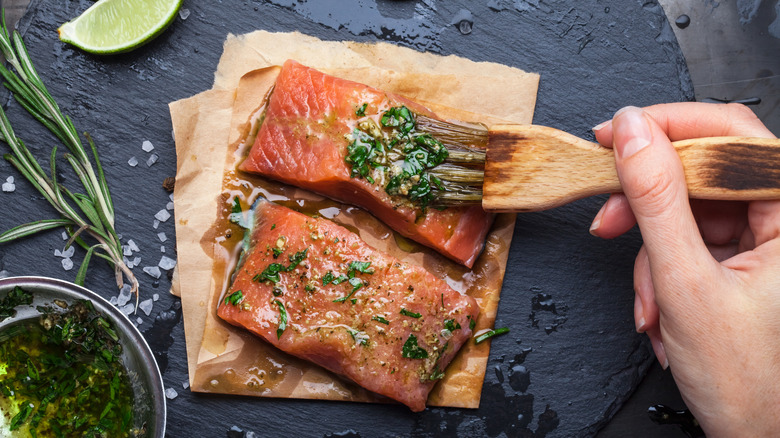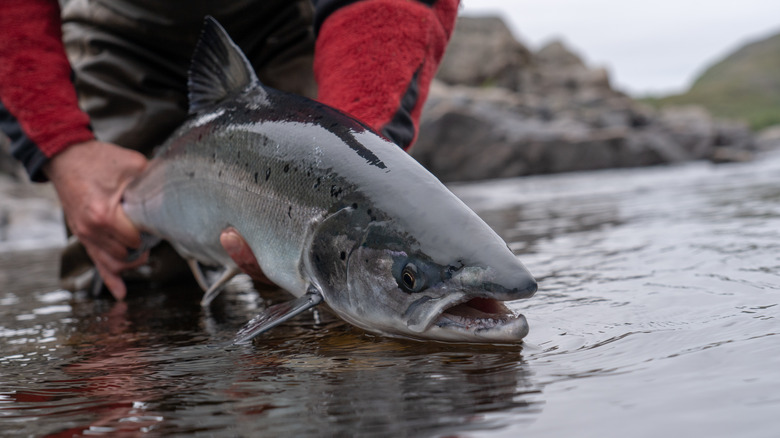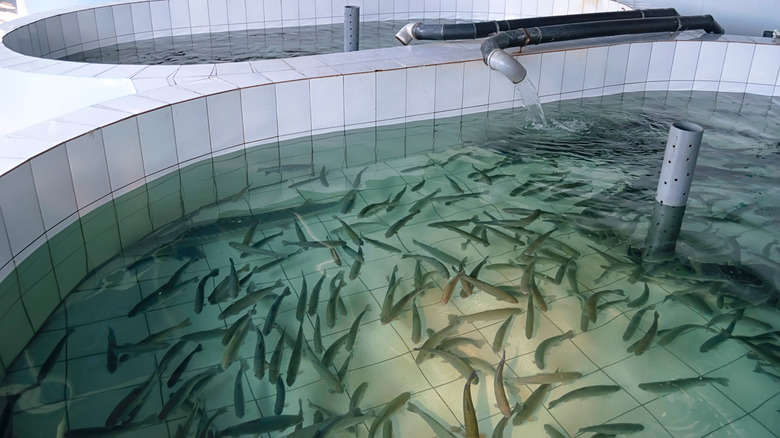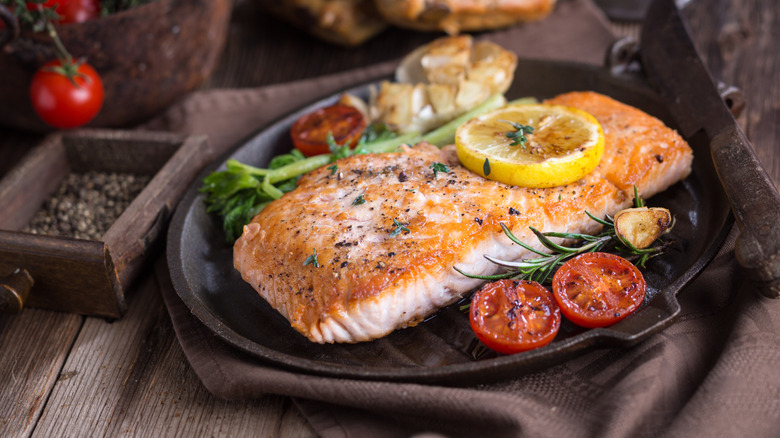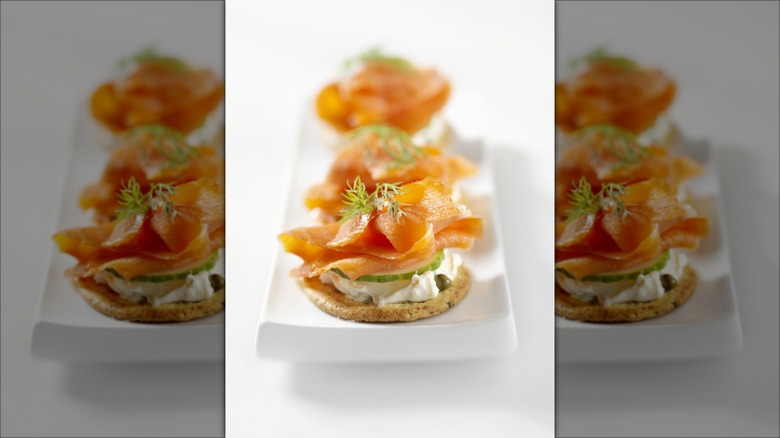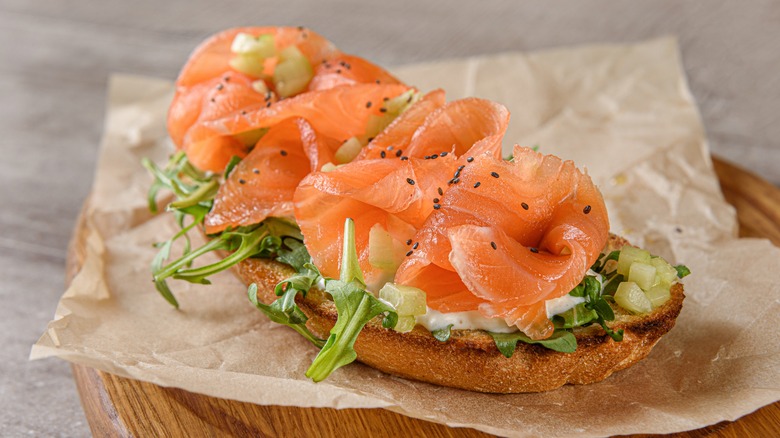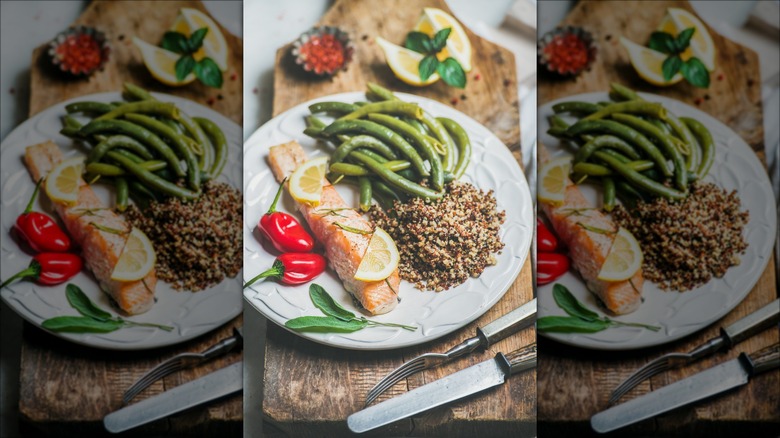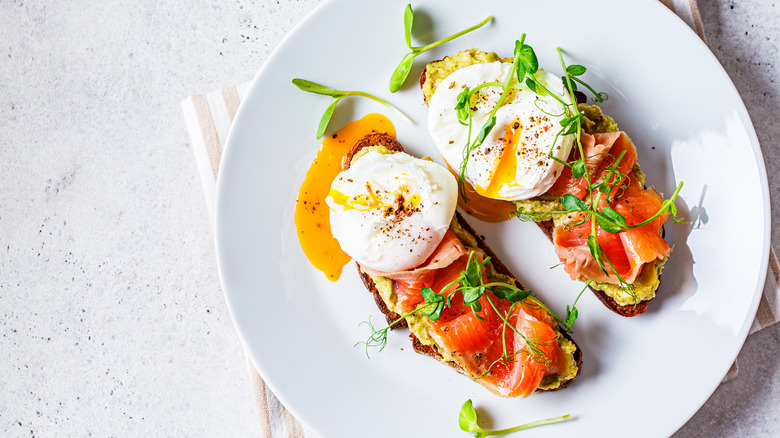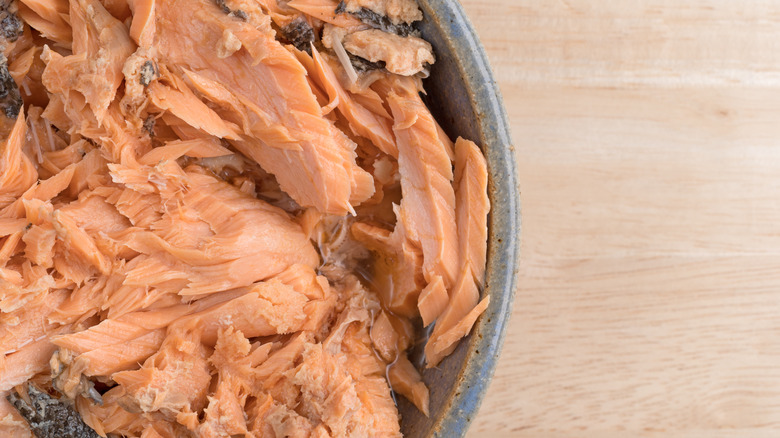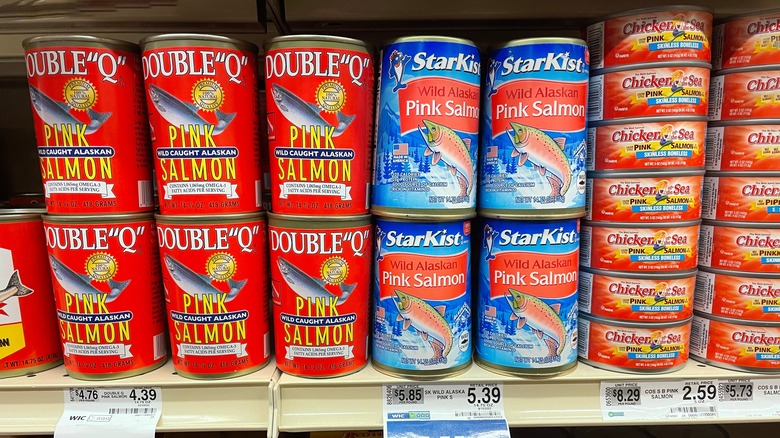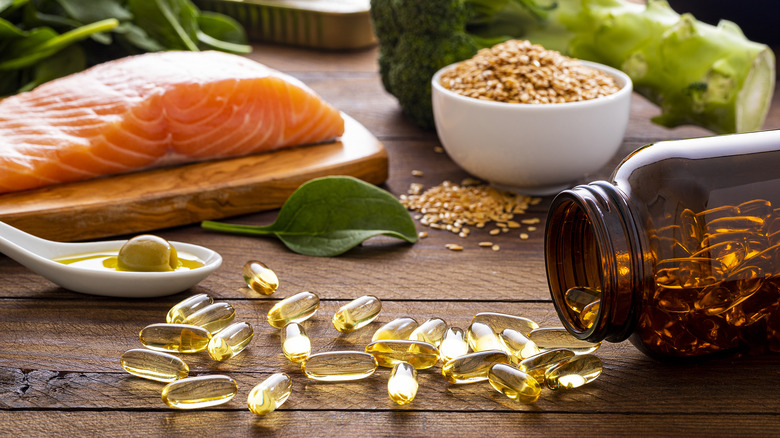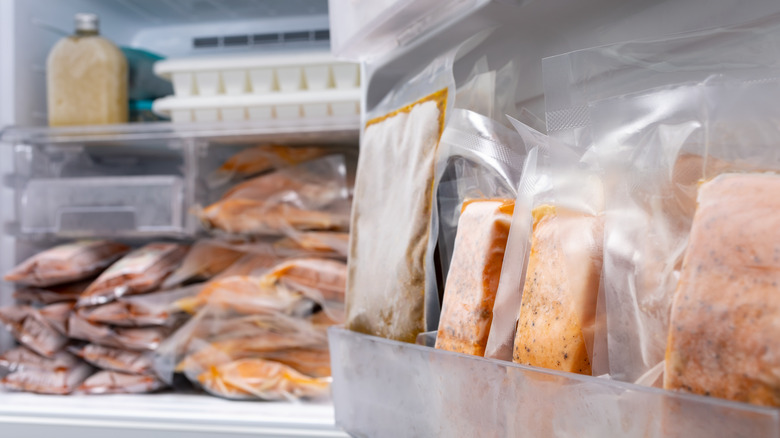The Only Salmon Guide You'll Ever Need
Salmon: It may qualify as the most popular fish in the world, a veritable feast of pink goodness for the eyes and the taste buds. It's a beloved and meaningful symbol to cultures around the world, including Native American and Celtic cultures, where it stands for wisdom, prosperity, and power. Very tellingly, in Irish myth, anyone who was fortunate enough to eat the Salmon of Wisdom was foretold to acquire deep, secret knowledge. Such was the salmon's power in the ancient world.
In the modern world, whether mankind gets wisdom from eating salmon has less to do with an infusion of magic and more to do with brain-boosting nutrients, like omega-3 fatty acids and all the B vitamins, one gets eating from a good salmon dinner. But if salmon were only good for you and not also delicious, it probably wouldn't be as popular as it is. Fortunately, it's both delish and good for you, too.
In this piece, you'll learn more about all that salmon has to offer as an ingredient. This includes a low-down on every type of salmon you can buy, from fresh to canned to smoked, as well as giving you an overview of costs and where you might find the best salmon.
What is salmon?
Salmon are an omnivorous fish species belonging to the Salmonidae family that can live in both fresh and saltwater, though where they're living at any given time depends on the fish's stage of development. Most people even vaguely familiar with salmon know, for example, that salmon are born in freshwater but eventually swim out to the ocean before returning to freshwater to spawn. This ability to live in both types of water makes salmon anadromous.
The most common type of salmon is the Atlantic salmon (Salmo salar), which can grow to lengths of four feet. There are seven species of Pacific salmon (Oncorhynchus), and while there is a wild salmon industry, most of the salmon are farmed fish. A lot of this has to do with practicalities. That is to say, because of overfishing, certain species of salmon, such as the Atlantic salmon, have been almost fished out of existence. As a result, you can only find wild Atlantic salmon, for example, in a few places in the state of Maine. Finally, salmon are also known by their subspecies names, too, like coho, sockeye, and chinook. (It's also worth noting that trout and whitefish belong to the Salmonidae family.)
How is salmon sourced?
Every June and July, salmon lovers rejoice because that's when wild Pacific salmon is harvested. This salmon harvest fest goes on until about September, and it could include salmon from all along the Pacific Rim, including South Korea and Russia, to the coasts of California and Alaska. And while many foodies love the wild salmon that comes from these harvests, wild salmon is only a part of the sourcing picture. Farm-grown salmon are actually far more common, with nearly 72% of the world's farmed salmon coming from the Atlantic salmon crop, per the Marine Stewardship Council.
There are some salmon from the Atlantic that are also wild, but for the most part, salmon from this neck of the woods come from fish farms. While it's possible to learn where your salmon comes from, if you can't figure it out, it's safest to assume that your salmon has been farmed from the Atlantic crop. Farmed salmon will sometimes get a label called "Best Choice," making choosing quality, sustainably farmed salmon a bit easier.
The "Good Alternative" label is the next best thing. It indicates that most of the salmon in that crop comes from sustainable fisheries. However, some of this salmon could also come from populations that are overfished. The best Atlantic salmon comes from either Maine in the U.S. or the Faroe Islands in Denmark.
What does salmon taste like?
Salmon has a taste all of its own, which is why it's so popular in so many recipes. Its flavor is stronger than its freshwater cousin, the trout, but it's also not exactly like tuna. To further complicate matters, salmon can even taste different when compared against itself. For example, depending on whether you are eating fresh salmon, smoked salmon, or even raw salmon, you're going to have a different taste experience. Where the fish comes from, whether it's wild or farmed, and a number of other influences also affect how salmon tastes.
For those who don't like to take a risk on a new taste, this aspect of salmon's taste might be off-putting. However, for foodies who love a food adventure, salmon has a lot to offer. It tastes like fish, but it isn't fishy like the bottom of a lake if that makes sense. The meat of salmon is usually tender, and its golden pink color counts among salmon's most defining features. For the most part, it also doesn't tend to be heavy. While you can certainly get full eating a salmon dinner, it won't sit in your stomach like a New York strip or ribeye steak will. This lightness is evident in the taste as well.
Types of salmon to eat
It's difficult to get bored when salmon is on the menu because salmon takes so many forms. In its simplest form, it is raw inside your sushi roll or is cut as sashimi strips that you eat over steamed rice with a little bit of soy sauce and wasabi. Raw salmon tastes very different than lox salmon, which is a salt-cured salmon that people love to lay over a bagel slathered with cream cheese and seasoned with capers. Add a cup of coffee, and you've got yourself the quintessential deli lunch.
Smoked salmon brings the smoky flavor that people love in foods like bacon but combines it with salmon instead. Other types of salmon are made for convenience. Two examples include canned and dehydrated salmon. Canned salmon is something that you can put into your pantry as a staple item, just like you would tuna fish. Dehydrated salmon is the jerky of the salmon world. People who are on the go like it because it's easy to carry around and it's an excellent source of protein.
What differentiates lox from smoked salmon?
Many people use the words "lox" and "smoked salmon" interchangeably, but, in reality, true lox is different than smoked salmon — though they do share some common characteristics. The differences between the two affect how they taste, and those who have tasted both know the difference.
In a nutshell, both lox salmon and smoked salmon get cured with salt (or sometimes, sugar). However, only smoked salmon gets the further step of being smoked as well. To make matters all the more confusing, the lox that people know as Nova Scotia Lox is actually smoked salmon. It's sometimes referred to as Nova Lox. Gravlax is Scandinavian lox that gets not only salt, but sugar, dill, and other spices. In traditional settings, it's prepared underground, which is also what gives it its name. "Grav" means "grave," and "lax" is lox or salmon in the old Swedish language.
As well there's even a difference in the kind of smoking technique, which can either be hot or cold smoked. Hot smoked salmon is what people commonly refer to as kippered snacks. Nova Lox gets the cold smoked treatment. You know something is cold smoked if it's smoked at 86 F or less. The flavor of the smoke in the smoked salmon is affected by not only the type of wood that it's smoked in but also whether or not the salmon is cured with salt or sugar.
Is dried or dehydrated salmon a viable meal option?
For many avid outdoorsy types, dried meats like jerky provide the fuel to get through a long hike or bike ride without all the additives that you might find in your average protein bar. The word "jerky" conjures up strips of dried beef or turkey, but as it turns out, salmon makes pretty good jerky, too. In practical terms, salmon jerky gives the trailblazer 15 grams of protein for every 80 calories you eat. To put that into perspective, you'll only get 12 grams of protein from beef jerky with the same calorie count. And it's difficult to overlook the convenience factor. While some may not look at salmon jerky as a replacement for pot roast, it fills you up in the right way when you're on the go, leaving you satiated without making you stuffed.
That said, some clever cooks have learned to use dried meats like jerky in their recipes. It can be crumbled on a salad in the same way that bacon bits can be. Snack boards are also better for having some salmon jerky as a platter offering. Add some salmon savory to your morning scrambled eggs. Or take your salmon sushi up a notch by adding some crunch factor to your sushi rolls.
How to cook with fresh salmon
Given how many types of salmon there are, you'd be forgiven for thinking that fresh salmon is a little bit passé. But for the experienced home chef, cooking salmon is a playground for the senses and a cooking challenge to master. There are so many ways to prepare it. Once you know a few of them, it's likely you'll never think of it as a mundane dish again.
Dunk it in some marinade and throw it on the grill in the summertime, along with some garden veggies, and you have a light and refreshing seasonal dinner. Or try baked salmon covered with a crust of Dijon mustard, bread crumbs, Parmesan cheese, and white pepper complements just about every side dish you can imagine, from mashed potatoes to dry-cooked string beans. On the other hand, if you're looking for something light for brunch, why not try a delicious poached salmon recipe, served with some steamed asparagus on the side?
Or if you want something quick, pour a bit of olive oil into a skillet, lay out some salmon fillets in the pan, and season the fish with simple seasonings like garlic, butter or oil, and some lemon. Salmon filets cook in minutes, so they're a nice option if you haven't thought dinner out and you're starving when you get home from work.
What are some options for cooking smoked and cured salmon?
The way these types of salmon are processed means that there is little to no cooking required. And because cooking is not required, the salmon dishes that you make with these types of salmon can be put together at the last minute.
Smoked salmon can either be hot or cold smoked. Because cold smoked salmon is cooked at temperatures between 80 F to 90 F, it's considered raw. This gives you some flexibility, meaning that it tastes just as good in smoked salmon sushi as it would with angel hair pasta and broccoli. And, naturally, there is the old standby of bagels and cream cheese with smoked or cured salmon. The sushi and the bagel recipes require no heating or cooking at all. Cured salmon would work well in these recipes, too. In all cases, what cold smoked salmon brings to recipes is a smooth yet firm texture that nearly melts in your mouth.
Hot smoked salmon is smoked at higher temperatures, usually between 120 F to 225 F, with the fish reaching internal temperatures of up to 140F. Cooking times range from six to 12 hours. Its texture is very different from cold smoked salmon. It breaks off easily into flaky pieces, and its textural and flavor profile makes for a tasty snack straight out of the package. It's also a good option for smoked salmon omelets or smoked salmon potato au gratin.
Cooking with canned salmon
Much of the time, canned salmon works just as well in a recipe as its fresh counterpart will. It's the salmon in your salmon chowder, makes a delicious salmon fettuccine, and provides a base for salmon cakes in your favorite salmon patty recipe. It also gives you ready access to some easy lunch and dinner fare. In many ways, keeping canned salmon in your pantry is no different than keeping canned tuna. Many of the recipes work with salmon as well as they would with tuna. Salmon salad sandwiches or salmon cream cheese dip come to mind here. And adding a bit of protein to your morning toast becomes easier, too. Toast your bread as usual, and then smear a topping of avocado, canned salmon, and your favorite seasonings for a quick breakfast. It's quick and easy, requiring very little fuss or even cooking skills.
Canned salmon is also a nice option for lighter fare as well. For example, if tuna and green salad count among your go-to lunch options, replace the tuna with canned salmon. Or do you have everything for tacos minus the meat? If you have canned salmon, black beans, and other salad-like fixings, it only takes a couple of minutes to put together some fish tacos starring canned salmon as the meat du jour.
Where to buy salmon
Because so many different kinds of salmon exist, understandably the prices for it vary broadly. At a local grocery store like Fred Meyer, you can find 8 ounces of sockeye salmon for $7.00. A filet of Atlantic salmon will cost you $10.99 at Albertsons, while a fresh seafood salmon gift pack care of Seattle's Pike Street Marketplace runs as high as $296.00, which is maybe unsurprising for a specialty store in a touristy spot that's known for its fresh seafood.
On the other end of the spectrum, you log on to Amazon to find 32 ounces of frozen salmon for $29.99. Of course, Amazon is like the General Store of the Internet, so it's also possible to find canned salmon for your pantry, which will run you anywhere from $2.00 to $4.00, depending on the brand and the size of the can.
Generally speaking, a number of factors can affect the price of salmon. Most obviously, supply and demand have a lot to do with the price of this fish. If there's a low supply and a high demand, then the price will spike. Conversely, if there's a high supply and a low demand, the prices go down. Whether the fish is Atlantic or Pacific salmon or wild caught versus farmed fish also plays a role. It additionally matters if you buy fresh salmon, canned, frozen, or smoked. Even world politics, like the Russia/Ukraine conflict, can affect the price of salmon around the world.
Nutritional information about salmon
No matter how you slice it, eating salmon is a win-win for your health, and fortunately, due to the number of different forms that salmon comes in, you're bound to find at least one type of salmon that you like. That is to say, if you're not keen on canned or smoked salmon, you might be talked into having a little poached salmon every once in a while. All forms of salmon have plenty of vitamins, minerals, antioxidants, and essential fatty acids that your body needs. This includes even the snacky forms of salmon, like salmon jerky, which comes with plenty of omega-3s, as well as vitamins A, B, and D. Phosphorus, zinc, and calcium count among the minerals you'll get when you eat salmon.
Most salmon is low-fat, though wild salmon comes in lower on the fat scale than farmed salmon does, and wild salmon usually has fewer pollutants and contaminants in them than farmed salmon, so if you have a choice, choose wild salmon for your next meal. It's also worth mentioning that the human body can't make omega-3 fatty acids on its own. You must take them from your diet, and if a daily dose of salmon jerky or a little lox on a bagel is what does it for you, then eat up! All of these nutrients help the body fight off diseases like Alzheimer's, heart disease, and arthritis.
How to store fresh salmon
Unless your salmon is sealed happily in a can, you'll need to learn how to store it to prevent spoilage. To make all of this more understandable, let's start with what you would do with a fresh salmon that you purchased at the farmers' market or grocery store and intend to eat in a couple of days. Provided that your fresh salmon is still in the package you purchased it in and that package has no damage, it can go into the refrigerator. You don't want the temperature on that to go higher than 38 F or lower than 32 F. It also only has a shelf life of about two days. If you freeze your fresh salmon, it'll last in the freezer for up to eight months.
If you're storing smoked salmon in the fridge, cold smoked salmon will last about a week, while hot smoked salmon can be stashed in there for up to two weeks, and in the freezer for one month to up to 12 months, respectively. Finally, if you're storing leftover salmon, including opened canned salmon, wrap it tightly in plastic or put it into a sealed container to keep it away from air exposure. It needs to be in the coldest part of the fridge, where it will keep for three or four days. If you know you're not going to eat it in three or four days, you can freeze it for up to three months.
